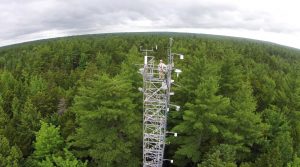Natural climate solutions (NCS) refer to a variety of land conservation and restoration actions that
increase carbon storage (or reduce greenhouse gas emissions) in forests and agricultural operations
(Fargione et al., 2018; Griscom et al., 2017). Reforestation, extending forest harvest intervals, and
avoiding conversion of forests to other uses are all important natural climate solutions. In agriculture,
natural climate solutions include changes in land management such as the use of cover crops or
rotational grazing. These and other practices promote soil carbon storage.

A useful NCS approach has several properties. First, the benefit will be “permanent”, at least over a 50-
100-year period. Second, it will create additional climate benefits that wouldn’t otherwise occur. Third, a
NCS should account for “leakage”, i.e., emissions that may occur elsewhere because of the economic
impact of the project. An example of leakage might be if harvest intervals are extended but as a result
trees are cut down sooner on another tract of land. Finally, there must be a net climate benefit when
considering all impacts (such as albedo change or other GHG emissions) of the solution. Importantly, a
useful NCS will maintain its carbon store even as the climate changes. Anderegg et al. (2020) discuss
how climate-driven risks may compromise the permanence of forest-based natural climate solutions.
Eddy covariance and associated data have a key role in understanding the functioning of Natural Climate
Solutions (Baldocchi and Penuelas, 2019; Hemes et al., 2021). Flux measurements can be especially
useful for detecting change in hard-to-observe carbon pools such as soils. Flux sites can also provide a
more complete picture of the climate impact of a NCS by monitoring energy exchange, other important
non-CO 2 greenhouse gas fluxes, and changes in surface characteristics such as albedo (Hemes et al.,
2021).
New results from the Howland Forest AmeriFlux site (“Multi-Decadal Carbon Cycle Measurements
Indicate Resistance to External Drivers of Change at the Howland Forest AmeriFlux Site”, doi:
10.1029/2021JG006276) show long-term persistence of C uptake and an increasing trend of C storage in
an aging evergreen forest. Questions remain about risk, the stability of C storage in different
ecosystems, and secondary climate impacts. These are questions that AmeriFlux and other flux networks
are ideally suited to address. Network researchers and data will be vital in the upcoming science and
policy debates about how best to use Natural Climate Solutions.
Learn more about Natural Climate Solutions at the upcoming 2021 AmeriFlux Annual Meeting – register here! There will be a plenary session on NCS, as well as a breakout discussion led by our NCS working group. Join us to get involved!
For More Info:
Anderegg, W. R., Trugman, A. T., Badgley, G., Anderson, C. M., Bartuska, A., Ciais, P., … & Randerson, J.
T. (2020). Climate-driven risks to the climate mitigation potential of forests. Science, 368(6497).
Baldocchi, D., & Penuelas, J. (2019). The physics and ecology of mining carbon dioxide from the
atmosphere by ecosystems. Global Change Biology, 25(4), 1191-1197.
Fargione, J. E., Bassett, S., Boucher, T., Bridgham, S. D., Conant, R. T., Cook-Patton, S. C., et al. (2018).
Natural climate solutions for the United States. Science Advances, 4(11), eaat1869.
Griscom, B. W., Adams, J., Ellis, P. W., Houghton, R. A., Lomax, G., Miteva, D. A., et al. (2017). Natural
climate solutions. Proceedings of the National Academy of Sciences, 114(44), 11645-11650.
Hemes, K. S., Runkle, B. R., Novick, K. A., Baldocchi, D. D., & Field, C. B. (2021). An Ecosystem-Scale Flux
Measurement Strategy to Assess Natural Climate Solutions. Environmental science & technology, 55(6),
3494-3504.

No Comments
Be the first to start a conversation